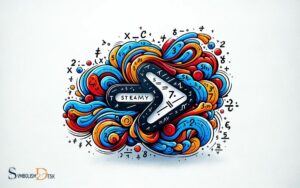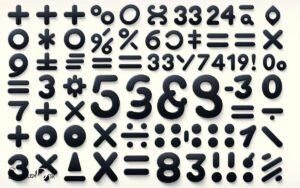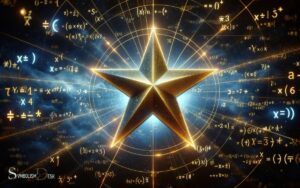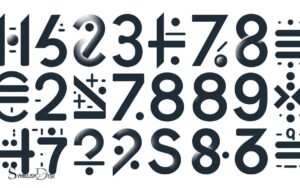Symbol of Intersection in Math: Upside-Down Letter U!
The symbol of intersection in math is represented by an upside-down letter U, “∩”. It denotes the common elements between two sets. For example, if Set A = {1, 2, 3} and Set B = {2, 3, 4}, then A ∩ B = {2, 3}.
The concept of intersection is fundamental in set theory, a branch of mathematical logic.
Here is an example to illustrate intersection:
The intersection of Set A and Set B (A ∩ B) would be the set of elements that are common to both sets:
- A ∩ B = {banana, cherry}
Key points about the intersection of sets:
The intersection symbol “∩” is essential in mathematics for identifying shared elements between sets, providing a visual and symbolic representation of this concept.
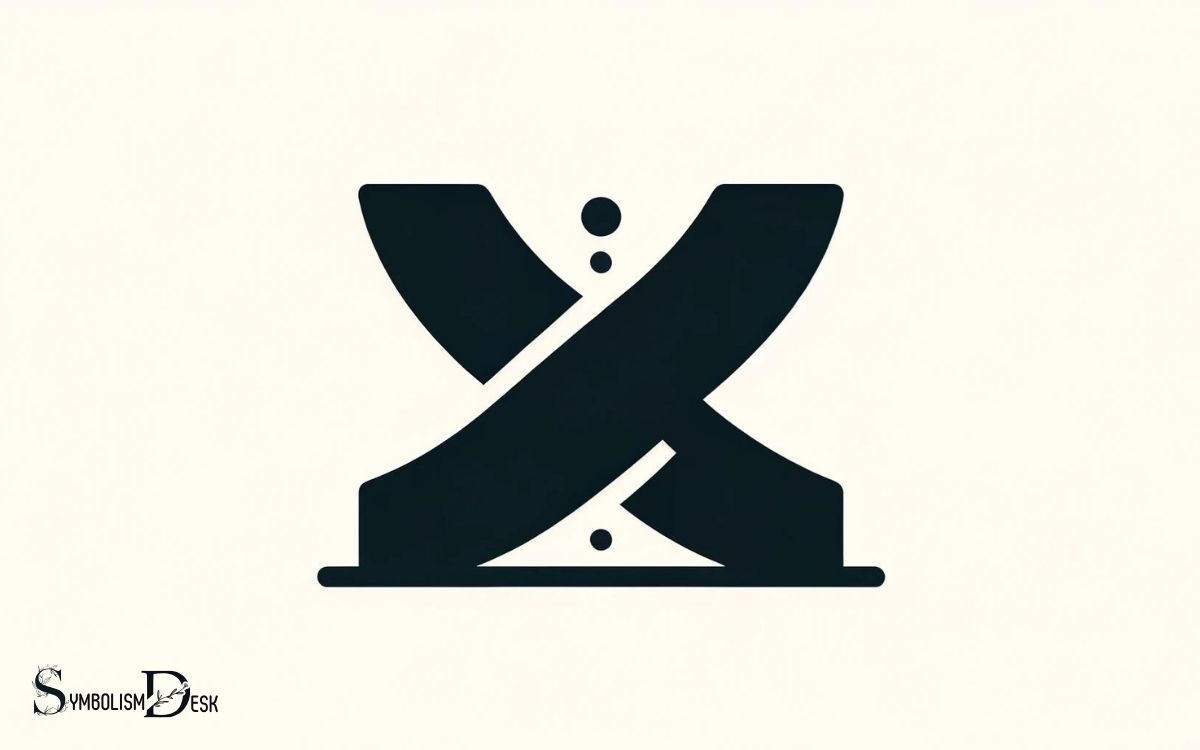
Key Takeaway
Origin and Meaning
The symbol of intersection in mathematics, denoted by the symbol ‘∩’, originates from set theory and represents the common elements shared between two or more sets.
It is derived from the logical operation of intersection, where it is used to denote the elements that are present in all given sets. In set theory, this symbol plays a crucial role in defining relationships between sets and is fundamental in various mathematical operations and proofs.
The symbol ‘∩’ is an essential tool in illustrating the overlap or commonalities between different sets, providing a concise and precise notation for mathematical expressions.
Understanding its origin and meaning is fundamental to grasping its applications in mathematical operations. With this understanding in place, it is now essential to delve into its notation and usage in mathematical contexts.
Notation and Usage
Originating from set theory, the symbol of intersection, denoted by ‘∩’, is employed to represent the common elements shared between two or more sets.
Notation and usage of the intersection symbol are crucial in various mathematical applications:
- Set Notation: The symbol ‘∩’ is used to denote the intersection of sets, where the resulting set contains only the elements that are common to all the sets involved.
- Logical Operations: In logic and Boolean algebra, ‘∩’ represents the logical AND operation, where the result is true if and only if all the inputs are true.
- Probability: The intersection symbol is utilized to calculate the probability of the occurrence of two or more events simultaneously, providing a fundamental concept in probability theory.
Understanding the notation and usage of the intersection symbol is fundamental for effectively working with sets, logic, and probability.
Properties and Characteristics
With regards to the symbol of intersection in mathematics, it is important to delve into its properties and characteristics to gain a comprehensive understanding of its utility.
The intersection of sets A and B, denoted as A ∩ B, represents the elements that are common to both sets. One of its fundamental properties is that the result of an intersection operation is always a subset of each of the original sets.
Additionally, the commutative property holds true for the intersection of sets, meaning that A ∩ B = B ∩ A.
Furthermore, the intersection of sets is distributive over union, following the principle that A ∩ (B ∪ C) = (A ∩ B) ∪ (A ∩ C).
Understanding these properties and characteristics is essential for effectively utilizing the intersection symbol in various mathematical applications.
Venn Diagram Representation
Delving into the Venn diagram representation of the intersection of sets in mathematics provides a visual tool to illustrate the common elements between sets A and B. This graphical method aids in understanding the relationship between different sets and their intersections.
Here’s how Venn diagrams enhance comprehension:
- Visual Representation: Venn diagrams offer a clear and intuitive visual representation of the intersection of sets, making it easier to comprehend the shared elements.
- Set Comparison: They enable a straightforward comparison between sets A and B, highlighting both their unique elements and the elements they share.
- Logical Clarity: Venn diagrams provide a logical and systematic approach to understanding the intersection of sets, aiding in problem-solving and analysis.
Applications in Set Theory
The application of intersection in set theory plays a crucial role in determining common elements between sets.
By employing set operations with intersection, mathematicians can precisely analyze the relationships between different sets.
Venn diagrams also utilize intersection to visually represent the common elements shared by different sets, providing a graphical understanding of the concept.
Set Operations With Intersection
The use of set operations with intersection plays a fundamental role in set theory, serving to demonstrate the relationships and common elements between different sets.
Set operations with intersection are applied in various mathematical and real-world scenarios, including:
- Logic: In logic, set intersection is used to find common elements between different propositions or statements.
- Database Queries: Intersection is used in database queries to retrieve data that satisfies multiple conditions.
- Probability: In probability theory, set intersection is used to calculate the likelihood of multiple events occurring simultaneously.
Understanding set operations with intersection is crucial for analyzing relationships between sets and determining common elements.
This concept sets the foundation for further exploration of set theory, including the application of Venn diagrams and intersection to visually represent relationships between sets.
Venn Diagrams and Intersection
Applications of Venn diagrams and intersection in set theory provide visual representations of relationships between sets, aiding in the analysis of common elements and overlaps.
Venn diagrams, consisting of overlapping circles or other shapes, illustrate the intersections and unions of sets.
The intersection of sets A and B, denoted as A ∩ B, represents the elements that are common to both A and B. This concept finds practical applications in various fields such as statistics, logic, and computer science.
In set theory, the intersection operation allows for the comparison and categorization of data, facilitating the understanding of shared characteristics and relationships between different sets.
By visually depicting the intersection of sets, Venn diagrams offer a powerful tool for conceptualizing and solving problems related to overlapping elements within sets.
Intersection With Other Symbols
When working with the symbol of intersection in math, it is important to understand its interaction with other mathematical symbols. This interaction can significantly impact the outcome of mathematical expressions and equations. For example, the intersection symbol (∩) often works in conjunction with other set theory symbols such as union (∪) or subset (⊆) to express relationships between sets. Understanding the math symbol sideways u meaning, which typically represents a subset, can help clarify how sets interact and overlap within a given problem. By mastering these symbols and their respective meanings, one can interpret and solve complex mathematical scenarios with greater accuracy.
Here are some key interactions to consider:
- Union (⋃): The intersection symbol (∩) can be combined with the union symbol to express complex relationships between sets.
- Complement (’): When the intersection symbol is used with the complement symbol, it represents the elements that are in one set but not in another.
- Subsets (⊆): The intersection symbol can be used to determine the common elements between subsets of a larger set, providing insights into set relationships.
Understanding how the intersection symbol interacts with these and other mathematical symbols is crucial for accurate and meaningful mathematical analysis.
Intersection in Probability
When discussing intersection in probability, it is essential to consider the probability of intersection between events. This involves the calculation of the likelihood of two or more events occurring simultaneously.
In set notation, the intersection is denoted by the symbol ∩ and is used to represent the common elements between sets in the context of probability.
Probability of Intersection
Studying the probability of intersection in mathematics involves analyzing the likelihood of two or more events occurring simultaneously.
When calculating the probability of intersection, certain key principles are essential to consider:
- Multiplication Rule: This fundamental rule states that the probability of the intersection of two events is the product of the probability of each event occurring individually, given that the first event has occurred.
- Independent Events: When events are independent, the probability of their intersection is simply the product of their individual probabilities.
- Dependent Events: In the case of dependent events, the probability of the intersection is calculated using conditional probability, considering the outcome of the first event when determining the probability of the second event.
Understanding these principles is crucial in solving complex probability problems and making informed decisions based on the likelihood of multiple events occurring together.
Set Notation for Intersection
How do mathematicians represent the intersection of sets in probability theory? In set notation, the intersection of two or more sets A and B is denoted as A ∩ B. This symbol represents the elements that are common to both sets.
In the context of probability, the intersection of sets is used to calculate the probability of two or more events occurring simultaneously.
For example, if A represents the event of drawing a red card from a deck of cards and B represents the event of drawing a face card, then the intersection A ∩ B represents the event of drawing a red face card.
The probability of this intersection is calculated using the formula P(A ∩ B) = P(A) * P(B|A), where P(A) is the probability of event A and P(B|A) is the conditional probability of event B given that event A has occurred.
This set notation for intersection is fundamental in probability theory for determining the likelihood of multiple events occurring together.
Practical Examples and Exercises
To gain a better understanding of the symbol of intersection in mathematics, work through the following practical examples and exercises.
- Example 1: Given two sets A = {1, 2, 3, 4} and B = {3, 4, 5, 6}, find the intersection of A and B.
- Example 2: For sets C = {red, green, blue} and D = {blue, yellow, black}, determine the intersection of C and D.
- Exercise: Create two sets of your choice and calculate their intersection. This will help reinforce the concept of intersection and its application in real-life scenarios.
Conclusion
The symbol of intersection in math represents the common elements between sets, creating a visual and conceptual representation of shared characteristics.
Its notation and properties make it a fundamental concept in set theory and probability, with practical applications in various fields.
Like a Venn diagram illustrating the overlap between different circles, the intersection symbol serves as a bridge connecting different mathematical concepts and helping to uncover new insights and relationships.

